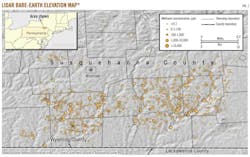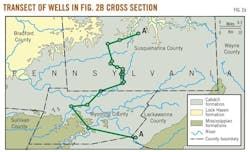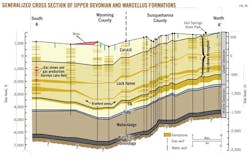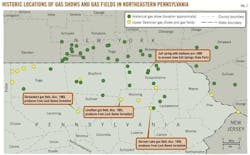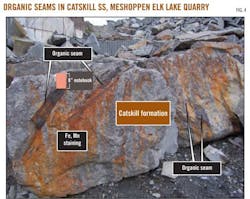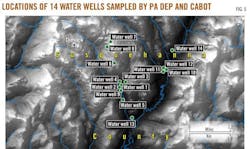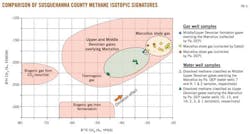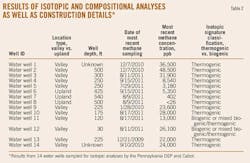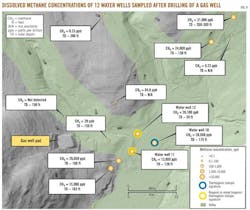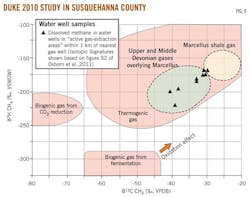Methane in Pennsylvania water wells unrelated to Marcellus shale fracturing
Lisa J. Molofsky
John A. Connor
Shahla K. Farhat
GSI Environmental Inc.
Houston
Albert S. Wylie Jr.
Tom Wagner
Cabot Oil & Gas Corp.
Pittsburgh
Results from more than 1,700 water wells sampled and tested prior to proposed gas drilling in Susquehanna County, Pa., show methane to be ubiquitous in shallow groundwater, with a clear correlation of methane concentrations with surface topography.
Specifically, water wells located in lowland valley areas exhibit significantly higher dissolved methane levels than water wells in upland areas, with no relation to proximity of existing gas wells. The correlation of methane concentrations with elevation indicates that, on a regional level, elevated methane concentrations in groundwater are a function of geologic features, rather than shale gas development.
Technical literature and historical publications confirm the presence of methane gas in natural seeps and water wells in this region for many decades, long before shale gas drilling operations were initiated in 2006.
Potential sources of this naturally occurring methane include thermogenic gas-charged sandstones in the Catskill formation, which are tapped by most water wells in this region. These sandstones exhibit an extensive network of fractures, joints, and faults that serve as principle conduits of groundwater flow and potential pathways for the movement of shallow-sourced dissolved methane.
Biogenic methane, which is produced by the natural decomposition of organic material within thick valley alluvium and glacial drift deposits in the area, may also be found in water wells that draw water from shallower sediment deposits.
The source of this dissolved methane is important with regard to understanding the potential effects of ongoing shale gas development and the appropriate measures for protection of water resources.
In 2009 and 2010, the Pennsylvania Department of Environmental Protection (DEP) conducted stable isotope analyses of methane in gas wells and water wells in Susquehanna County, which indicated that the isotopic signature of thermogenic gas from Upper and Middle Devonian deposits overlying the Marcellus shale can be distinguished from that of Marcellus shale gas.
The ability to distinguish between different formation gases has important implications with regards to the findings of the recent study by researchers from Duke University,1 which suggested that the thermogenic signature of elevated methane concentrations in water wells in Susquehanna County was consistent with an origin in deep shale gas deposits, such as the Marcellus and Utica formations, that are currently targeted by hydraulic fracturing activities.
The present study, however, shows that the isotopic signatures of the Duke study's thermogenic methane samples were more consistent with those of shallower Upper and Middle Devonian deposits overlying the Marcellus shale. This finding indicates that the methane samples analyzed in the Duke study could have originated entirely from shallower sources above the Marcellus that are not related to hydraulic fracturing activities.
The apparent misinterpretation of the origin of the observed thermogenic methane underscores the need for a multiple lines-of-evidence approach for proper characterization of methane gas sources, with careful integration of the relevant geologic, historical, well construction, and isotopic data.
Methane in Susquehanna County groundwater
From May 2008 through 2009, in accordance with current Pennsylvania DEP guidelines, Cabot Oil & Gas Corp. collected water samples from all existing water wells within 1,000 ft of proposed gas well drilling sites.
From 2010 to the present, the sampling program was extended to include all water wells within 2,500 ft of proposed gas well drilling sites in anticipation of revised Pennsylvania DEP guidelines.
Collectively, these samples were submitted for "predrill" analysis of water quality parameters including concentrations of dissolved gases (methane, ethane, propane) and general chemistry analyses pertaining to primary and secondary drinking water standards.
Cabot also collected an extensive background set of water samples in an 80 sq mile area in Brooklyn, Harford, and Gibson townships in 2011 for analyses of dissolved gases. In total, these 1,713 measurements (dating from 2008 through 2011) provide a baseline characterization of groundwater conditions prior to proximate oil and gas drilling, hydraulic fracturing, or production activities (Fig. 1).
The results of the extensive "predrill" water well sampling and background survey show methane to be nearly ubiquitous in water wells in this region, with over 78% of the water wells exhibiting detectable methane concentrations. In Fig. 1, dissolved methane concentrations have been plotted on a Light Detection And Ranging (LiDAR) bare-earth elevation map.
The spatial distribution of methane concentrations shows a clear relationship with surface topography, with measurably higher dissolved methane concentrations in water wells located in valleys (topographic lows) relative to upland areas.
To support statistical analysis, LiDAR digital elevation models and the USGS National Hydrography Dataset (NHD) have been used to characterize water well locations in valleys (defined as the area within 1,000 ft of a major NHD flowline, i.e., major drainage, and 500 ft of minor tributaries to NHD flowlines) or uplands (greater than 1,000 ft or 500 ft from a major or minor drainage, respectively).
Although only 51% of the sample locations are in the valleys, valley wells represent approximately 88% of the wells containing dissolved methane concentrations in excess of 7,000 ppb (the current methane action level for water wells established by the Pennsylvania DEP). In addition, a Kruskal-Wallis one-way analysis of variances shows a statistically significant difference between methane levels in lowland (841 locations) vs. upland water wells (872 locations) (p-value <0.001).
(While the Kruskal-Wallis test does not require normally distributed populations, equal population variances are assumed. Consequently, a Box-Cox variance-stabilizing transformation, based on Levene's test, was performed on the data set prior to analysis.)
The results of these statistical analyses are supported by testimony from water well drillers in Susquehanna County, who note that water wells with gas shows are most commonly observed in valleys.2
Similar conditions were observed in a study by the US Geological Survey in West Virginia in 1997-2005, where data sampled from 170 water wells found methane concentrations exceeding 10,000 ppb to occur only in wells located in valleys and hillsides, rather than hilltops.3
Susquehanna County has been the focus of extensive natural gas development in recent years, with 303 gas wells drilled from July 2006 to September 2011.4
The water well dissolved methane concentration data presented in our current study were collected "predrill," i.e., prior to nearby drilling activities; consequently a relation of these dissolved methane concentrations to gas production activity would not be expected.
Nevertheless, the data have been evaluated for a possible relation to drilling activity by subdividing the data set of water wells sampled through 2011 into locations in "gas production areas" (conservatively defined as the area within 1 km of gas wells drilled prior to 2011) and locations in "nonproduction areas" (i.e., no gas well drilled prior to 2011 within 1 km).
Based on this comparison, the methane concentrations in water well samples exhibit no relationship to existing gas production activities. Specifically, a Kruskal-Wallis one-way analysis of variance, comparing dissolved methane concentrations at locations within 1 km of the nearest drilled gas well (527 water wells) to concentrations at locations greater than 1 km from the nearest gas well (1,186 water wells), shows no statistically significant difference between these populations (p-value = 0.4).
The records of the Pennsylvania DEP indicate that an additional 84 gas wells were drilled in January-September 2011. As a second conservative check, we have repeated this statistical analysis using all gas well drilling locations through September 2011 (some of which may have been drilled after the water well samples were collected). This analysis was also found to show no statistically significant difference in dissolved methane between production and nonproduction areas (p-value >0.9).
This observation echoes that of a November 2011 study by the Center for Rural Pennsylvania,5 which sampled 48 water wells in Pennsylvania at varying distances (284-2,500 ft) from gas wells both before and after drilling and fracturing activities, and found no significant relationship of methane concentrations to distance from a gas well. The correlation of elevated methane concentrations with topography, rather than oil and gas operations, suggests an origin rooted in the underlying geology of northeastern Pennsylvania.
Geologic conditions in Susquehanna County
Understanding the geologic and hydrogeologic context of Susquehanna County is important for determining the source of elevated methane gas concentrations observed in lowland water wells (Figs. 2a and 2b).
Susquehanna County is in the northeastern Appalachian basin, an area characterized by Paleozoic sedimentary rocks including organic-rich shales, siltstones, sandstones, and carbonates deposited in marine and fluvial environments.
These formations frequently contain "thermogenic gas," which formed from the burial of entrained organic material at sufficient temperatures and pressures within the earth to generate hydrocarbons abiotically. These thermogenic sources are distinct from "biogenic" methane, which forms from the biodegradation of organic material in the shallow subsurface, such as in alluvial and glacial drift deposits.
Most of the sedimentary shale deposits currently being developed for shale gas in the Appalachian basin formed during the Devonian period, subdivided by age into the Upper Devonian (359 million to 385 million years ago), Middle Devonian (385 million to 398 million years ago), and Lower Devonian (398 million to 416 million years ago) epochs.6 The characteristics of the principal geologic strata, and associated groundwater resources, beneath Susquehanna County are as follows, in order of increasing depth:
1. Quaternary.
Glacial drift and alluvium.
Surface geology is dominated by deposits of glacial drift (glacial till and outwash) and Quaternary alluvium, including sands, silts, clays, peat, and gravel.7-10
These deposits typically range from tens of meters thickness in valleys and drainages to a few meters on mountain tops.11 A limited number of water wells are completed in this stratum; however, drilling logs show that most water wells extend into the underlying sandstone bedrock.12
2. Upper Devonian.
Catskill formation.
The Catskill formation, consisting of sandstone, shale, siltstone and conglomerate, underlies the surficial deposits. The Catskill formation outcrops on ridgetops in the majority of Susquehanna County (with the exception of the northern and northwestern portions of the county), and is roughly 1,800 ft thick.9 The Catskill contains numerous sandstone beds that are water-bearing and is the primary aquifer accessed by local water wells, which are usually completed through glacial drift and alluvium into the unconfined aquifers of the Catskill formation at typical depths of 200 to 400 ft.12-15
In Susquehanna County, groundwater flow in the Catskill sandstone is primarily controlled by fracture flow through secondary porosity,16 with overall regional groundwater flow moving from north to south.17 Most water wells completed in the Catskill formation contain casing with only limited grouting, and are unsealed so as to draw groundwater from multiple water-bearing horizons and-or fractures.12
Lock Haven formation.
The Catskill formation is underlain by the Lock Haven (formerly Chemung) formation, comprised of interbedded units of sandstone, siltstone, and shale. The Lock Haven formation outcrops in the northwest and northern parts of the county and has been shown to contain brackish water.13 15
The Bradford sands, a locally known subdivision of the lower Lock Haven formation, is comprised of abundant sandstone deposits.
Brallier (Elk) formation.
Upper Devonian subsurface units beneath the Lock Haven include the Brallier, locally known as the Elk formation, and the Trimmers Rock formation in northeastern Pennsylvania.18 The Brallier and Trimmers Rock formations are comprised principally of interbedded sandstone, siltstone and shale.
3. Middle Devonian.
Tully limestone.
The Tully limestone, a fossiliferous calcareous shale, underlies the Lock Haven formation.
Hamilton Group (Mahantango formation and Marcellus shale).
Middle Devonian formations of the Hamilton Group can be found beneath the Tully limestone. These include the Mahantango formation, consisting of laminated shale, siltstone, sandstone, and claystone, and the carbonaceous Marcellus shale, which is located at the base of the Hamilton Group.
The Marcellus shale is currently the target of shale gas extraction throughout the Appalachian basin and has been estimated to contain as much as 84 tcf of gas.18 The Upper Devonian Catskill and Lock Haven formations have also been historically explored and drilled for oil and gas, although these shallow gas zones are not presently considered economical.
Table 1 summarizes numerous published records of gas shows in water and oil wells drilled into the Catskill and Lock Haven formations in Susquehanna County and surrounding areas over the past 200 years. For example, an oil boring described in an 1881 publication was reported to have encountered substantial amounts of gas while drilling to a depth of 680 ft within the Catskill formation.20
In addition, the Pennsylvania Geological Survey's 1922 publication "The Oil and Gas Fields of Pennsylvania" describes several instances of known shallow hydrocarbon production less than 2,100 ft beneath the surface in the Catskill formation in Wyoming County, directly to the south of Susquehanna County.21 Numerous other instances of methane gas encountered at depths ranging from 80 to 800 ft below grade in the Catskill or Lock Haven, dating to recent years, are indicated on Table 1 and Fig. 3.
Geologic studies suggest that, during deep burial of the Upper Devonian 270 million to 290 million years ago,22 oil within the organic rich strata of the Catskill and Lockhaven formations was cracked to gas. This gas was subsequently expelled and accumulated in overlying and adjacent sandstone stratum within the same formations.22
This finding is supported by the observation of numerous lenses of organic material in sandstone (bluestone) quarries and outcrops in Susquehanna County (Fig. 4). These organic seams have a measured vitrinite reflectance of 2.02, within the range sufficient to produce dry gas from organic material.23
A systematic and consistent fracture (i.e., joint) network is also observed in Upper Devonian bedrock exposures throughout the region.15 The locations of valleys and draws are commonly observed to be controlled by these fractures and joints.15 Vertical fracture planes are primarily oriented north-south, with penetrative planar fractures cutting through both the sandstone and shale beds of the Catskill formation.24 Inferior fracture sets are oriented west-east, northeast-southwest, and northwest-southeast, and stress relief fractures and bedding plane partings are also developed in the area.13 Iron staining and other mineral precipitation is abundant along the north-south oriented fracture surfaces, serving as evidence of ground water flow via the fracture planes.
The LiDAR map shows various linear trends that are often related to near-surface fracturing, faulting, and glacial erosion patterns. Some surface drainages are observed to closely follow these lineations, such as Wyalusing Creek, a tributary of the Susquehanna River, which exhibits orthogonal drainage patterns that exemplify the relationship of surface drainages and regional geomorphology to existing fracture networks and surface fold trends.
Historical salt water and mineral springs are coincident with these predominant lineations, likely indicating that the fracture networks are continuous from the ground surface to the depth of the more brackish Lock Haven lithologies.13
Water wells completed in these fractured, gas-charged sandstones can therefore be expected to encounter gas of thermogenic origin. Water well drillers report that methane gas is frequently encountered while drilling water wells in Susquehanna County, particularly in lowland areas.2
In addition, the Pennsylvania DEP and other state of Pennsylvania agencies have issued guidelines recommending the routine venting of water wells due to the potential for methane gas accumulation from natural sources.25
The elevated levels of dissolved methane observed within valleys in Susquehanna County could be related to two possible geologic sources.
First, faults and fractures in the Upper Devonian Catskill and Lock Haven formations, which act as natural weak points for the formation of valleys, can serve as likely pathways for the transport of thermogenic methane from Upper Devonian formations into the shallow subsurface, presenting as seeps and springs in lowland areas (e.g., Salt Springs State Park).
In addition, the thicker alluvial deposits in valleys may serve to impede or confine the upward diffusion of thermogenic methane gas from the underlying Upper Devonian deposits, thereby contributing to elevated methane concentrations in the shallow subsurface.
The fact that uncased "openhole" water wells commonly draw water from multiple stratigraphic units and fracture zones at depth lends support to the potential thermogenic (vs. biogenic) origin of the methane gas, particularly for wells that extend to the depth of the Catskill sandstone. However, as valleys exhibit a greater accumulation of alluvial sediments than surrounding areas, natural biodecay of the organic material in peats and other sediments could also contribute biogenic gas to local groundwater.
Isotope analysis of water well gas
Isotope and other compositional analyses are useful tools for discerning between biogenic and thermogenic gas sources, as well as different sources of thermogenic gas in the subsurface.26
To characterize gas sources within water wells in Susquehanna County, isotopic data have been reviewed from 5 gas wells, 14 water wells, and one natural spring sampled by the Pennsylvania DEP and Cabot, as well as 9 water well samples analyzed in the same area during the recent study by the team from Duke University.1
During 2009 and 2010, in response to elevated methane concentration measurements in water wells in the town of Dimock in Susquehanna County, the Pennsylvania DEP conducted stable isotope and compositional analyses of gases from nearby shale gas extraction wells as part of an effort to determine the source of this stray gas migration (Fig. 5).
Based on a comparison of Marcellus production gases to overlying Upper and-or Middle Devonian gases encountered within the open annulus of a wellbore, the Pennsylvania DEP determined that the isotopic signatures of shallower thermogenic Upper/Middle Devonian gases and deeper Marcellus Shale production gases, although similar, are distinguishable in this area.27 28
The distinction between Marcellus and overlying Upper/Middle Devonian shale gases was based on a combination of carbon and hydrogen isotopic compositions of methane, which are typically expressed as δ13C and δ2H values. These δ13C and δ2H values proved to be valuable geochemical fingerprinting tools for identifying the subtle differences between shallower and deeper thermogenic sources in the Dimock area.
Differences in carbon and hydrogen isotopic compositions may be attributed to the increased thermal alteration experienced by organic matter in deeper formations, which can result in progressively more positive δ13C and δ2H values of methane that plot along a "thermal maturation pathway" trend.29-31 Additionally, different sources of organic matter may result in distinct stable isotope compositions.
Upper and Middle Devonian gases overlying the Marcellus may also be distinguishable based upon isotope analyses; however, in the Pennsylvania DEP study, the open well annulus connected these two zones and did not facilitate separate analyses.
The Pennsylvania DEP also analyzed groundwater samples from five local water wells for the matching suite of dissolved gas parameters, all of which were determined to be consistent with either Upper/Middle Devonian gases or just Upper Devonian gases overlying the Marcellus by the Pennsylvania DEP.
Several of the water wells were sampled multiple times, resulting in 11 total samples as shown on Fig. 6, which plots the isotopic signatures of gases identified as Marcellus, overlying Upper/Middle Devonian, and Upper Devonian. It is important to note that these isotopic signatures are representative of the study area and may vary regionally across the Appalachian basin. Specifically, other studies of thermogenic gas in different parts of Pennsylvania and the Appalachian basin have found the stable isotopic signatures of gases from the Marcellus and shallower Middle and Upper Devonian deposits to be less distinguishable.31
In 2009 and 2010, the Pennsylvania DEP and Cabot analyzed additional dissolved methane samples from nine more water wells in the Dimock area for the isotopic and compositional signatures of gases. Cabot also analyzed two samples of dissolved methane from a natural spring in Salt Springs State Park, which is the location of well known historic gas seeps. Several of the wells and the spring were sampled multiple times, amounting to 23 total samples (Fig. 7).
The results of these analyses show that the methane gas in seven of the nine water wells exhibited an isotopic signature consistent with that of thermogenic gas from the shallow Upper/Middle Devonian and Upper Devonian gas sources, i.e., less thermally mature than Marcellus gas.
Two of the nine wells exhibited an isotopic signature consistent with biogenic gas that may have undergone oxidation or potentially mixed with small amounts of thermogenic gas, two processes that would serve to increase the δ13C and δ2H values. The isotopic signature of methane in the natural spring in Salt Springs State Park also appears thermogenic in origin, though the more negative δ13C and δ2H values may indicate slight mixing with biogenic methane (Fig. 7). Information regarding the results of isotope and compositional analyses, as well as construction details of all 14 water wells sampled for isotope analyses by the Pennsylvania DEP and Cabot is provided in Table 2.
Of the 14 water wells sampled for isotope analyses by the Pennsylvania DEP and Cabot, 11 were located in valleys. Comparison of the methane concentrations in these lowland wells to those located in uplands supports the observation that higher methane concentrations are typically found in lowland water wells (Table 2).
The biogenic nature of gas originating from alluvium and glacial till vs. the thermogenic nature of gas migrating from Upper Devonian sandstone deposits is illustrated by the example in Fig. 8. As shown in the figure, three of the wells sampled for isotope analyses (water wells 10, 11, and 12) are located in the same valley in close proximity to one another and a neighboring gas well drilled in 2008 prior to sampling. (This figure also shows the locations, dissolved methane concentrations, and total depths of nine other proximate water wells sampled after drilling of the local gas well. However, these wells were not sampled for isotope analyses.)
It is important to note that although the dissolved methane concentrations and the locations of the three wells sampled for isotope analyses are relatively similar, the isotopic signatures of the methane are consistent with different sources. Water wells 11 and 12, for which available information indicates total well depths ranging from 30 to 120 ft terminating in shallow alluvium or glacial till, contain biogenic or mixed biogenic/thermogenic methane. In contrast, the remaining water well (water well 10) contains principally thermogenic methane consistent with that of Upper Devonian deposits.
Available information indicates this water well was drilled to a deeper depth of 175 ft into sandstone of the underlying Catskill formation. The presence of thermogenic methane in wells installed in the deeper Catskill sandstones is supported by data from the other 11 water wells sampled for isotope analyses by the Pennsylvania DEP and Cabot (Table 2), all of which appear to penetrate the Catskill formation and contain methane with isotopic compositions consistent with a thermogenic source.
As noted above, the isotopic signatures of the dissolved methane samples plotted in Figs. 6 and 7 fall within the range of isotope values consistent with an Upper or Middle Devonian source overlying the Marcellus, as established by the Pennsylvania DEP.
Hypothetically, a similar isotopic signature could be created by a mixture of Marcellus shale gas with methane from other sources, i.e., shallower Devonian gases and-or biogenic methane. Nevertheless, an assumption that Marcellus shale gas is the primary source of the thermogenic gas observed in these water wells is not supported by other lines of evidence in this region. Principally, historical and geological documents suggest that gases in the Catskill formation, which contains extensive fracture networks and is the primary water-bearing aquifer tapped by local water wells, are a more likely source.
Review of Duke University 2011 study
In 2010, Duke University researchers sampled 18 water wells in Susquehanna County to determine whether fracturing fluids or methane gases from deep shale gas formations had impacted shallow groundwater aquifers.1
The paper presented dissolved gas concentrations for all 18 water wells and carbon and hydrogen isotopic data for 9 samples, as shown on a supplemental plot. Thirteen of the 18 water wells were in "active gas-extraction areas," defined by the Duke researchers as located within 1 km or less of the nearest gas well, and five of the water wells were in "nonextraction" areas, defined as greater than 1 km away from the nearest gas well.
The researchers reported that methane concentrations in "active gas-extraction areas" were significantly higher than those in "nonextraction" areas. Isotope and compositional analyses of these elevated methane concentrations indicated the geochemical fingerprint to be consistent with a "thermogenic" gas source.
Within water wells located in "nonextraction" areas, average methane concentrations were reported to be lower than water wells located close to gas wells and the methane composition was predominantly of mixed thermogenic/biogenic origin.
Given the higher concentrations and thermogenic nature of methane in water wells proximate to shale gas wells, the Duke researchers asserted that hydraulic fracturing operations were facilitating the migration of deep thermogenic gas from the Marcellus and Utica shales into shallow drinking water aquifers in Susquehanna County. The study recommended increased monitoring and regulation of hydraulic fracturing operations to address such impacts.
The Duke study does not provide information regarding the locations of the sampled wells with respect to topography or the depths of the wells with respect to the Catskill formation. Therefore, we cannot evaluate their data with regard to these important factors. In addition, Duke only provides both δ13C and δ2H values only for wells in their active gas extraction areas in Susquehanna County, which does not facilitate characterization of the dissolved methane from water wells in nonextraction areas using these fingerprinting criteria.
However, comparison of the isotopic data presented in the Duke paper for wells in active gas-extraction areas to the isotopic gas characterization defined by Pennsylvania DEP and Cabot shows that eight of the nine water wells exhibit an isotopic signature consistent with thermogenic methane from the Upper or Middle Devonian deposits overlying the Marcellus shale (Fig. 9).
These data suggest that shallower Upper and Middle Devonian gases could account for the methane in the majority of the Duke water well samples without any contribution from Marcellus gas or the related hydraulic fracturing operations. At a minimum, given the similar signatures of shallower Upper/Middle Devonian gases and Marcellus shale gas, the conclusion of the Duke study that the thermogenic methane observed in these water wells was consistent with a Marcellus source was premature.
Our finding is based upon the limited isotopic data provided in the Duke paper. Future analyses, which may include a more complete suite of isotope data such as δ13C and δ2H values of ethane, propane, and other higher value chain hydrocarbons, will likely provide a more comprehensive characterization of gases from the Marcellus shale and shallower Middle and Upper Devonian deposits in this area.
The Duke researchers discuss three possible mechanisms for thermogenic methane migration into shallow drinking water aquifers: i) the displacement of gas-rich fluids from deep target formations, ii) enhanced migration of gas via newly created fractures, and iii) casing leaks from gas production wells.
The Duke study found no evidence of salinity impacts on the drinking water wells, indicating that fluid migration from the gas production zone had not occurred.
The comparable thermogenic isotopic signature of Upper Devonian gas to that observed in the water wells sampled by the Duke team, in conjunction with the much greater proximity of the Upper Devonian shales to the drinking water aquifers, suggests that the Upper Devonian is a more plausible source of the observed methane than upward migration of deep Marcellus gas via newly created fractures.
Furthermore, our evaluation of over 1,700 methane concentrations in gas production vs. nonproduction areas shows no relationship between dissolved methane and oil and gas activities, which is consistent with the fact that casing leaks, when and if they occur, would have only a localized effect.
Significance of findings
This study demonstrates that elevated methane concentrations in water wells in Susquehanna County are common and are correlated with topography rather than proximity to oil and gas operations, suggesting a geologic origin.
Consideration of regional geology, historical publications, water well completion records, and recent isotopic analyses indicates that naturally occurring methane is either thermogenic, originating from deposits overlying the Marcellus shale, or biogenic, originating from alluvial or glacial drift deposits.
In either case, the assertion by the Duke study that hydraulic fracturing of the Marcellus shale is contributing thermogenic methane to local water wells and shallow regional groundwater is unsubstantiated given the lines of evidence discussed in this paper. Rather, it appears that thermogenic methane encountered in water wells is related to the shallower Upper and-or Middle Devonian gases.
Historic records demonstrate that Upper Devonian thermogenic gas will be encountered by water wells or gas wells penetrating the Catskill formation. Water wells in the State of Pennsylvania currently have no uniform construction standards to prevent gas migration or other water quality issues.
To minimize potential impacts from shale gas wells, the Pennsylvania DEP has recently issued new regulations regarding the sealing, prevention and reporting of overpressurization, and inspection of gas production wells.32
Evaluating methane gas sources in groundwater
The evaluation presented in this article underscores the value of a "multiple-lines-of-evidence" approach for site-specific investigation of stray gas incidents.
Important lines of evidence include knowledge of underlying geologic stratigraphy, structure, and existing fracture systems; construction and completion details for the affected water wells and nearby gas production wells; historic information regarding prior stray gas incidents and evidence of naturally-occurring gas seeps; and prior analyses of the composition and isotopic signatures of gas sources.
As observed in this case, thermogenic gas can be sourced from various formations containing gases with carbon and hydrogen isotopic composition that may exhibit subtle variations. Complementing the isotopic analysis with characterization of the mass ratios of methane to ethane and to other higher chain hydrocarbons, as well as ratios of methane concentrations to those of carbon dioxide, nitrogen, and other gases, may provide greater resolution in some cases.
Careful consideration of the correct source of methane impacts, on a site-specific basis, is important for development of appropriate response actions for protection of water resources.
Acknowledgments
We thank Cabot Oil & Gas Corp. for permission to publish, as well as GSI Environmental Inc. for financial support of staff participation. Thanks to Dr. Emily C. Mercurio for LiDAR and National Hydrography Dataset manipulation and mapping. We appreciate the insightful suggestions and comments of the numerous GSI and Cabot reviewers that greatly improved the article. The LiDAR bare-earth Digital Elevation Model used in the study had 3-ft pixel resolution and was a proprietary data set. Horizontal accuracy of the LiDAR point cloud (from which the bare-earth DEM was generated) is 45 cm and vertical accuracy is 30 cm. Gray areas on Figs. 6, 7, and 9 representing the δ13C and δ2H values of methane of microbial and thermogenic origin are based on plots and data presented in Coleman et al., 1993, and Schoell, 1980.
References
1. Osborn, S.G., Vengosh, A., Warner, N.R., and Jackson, R.B., "Methane Contamination of Drinking Water Accompanying Gas-Well Drilling and Hydraulic Fracturing," proceedings of the National Academy of Sciences, Vol. 108, 2011, pp. 8,172-76.
2. Bell Bros. Well Drilling, Creswell Drilling, Beavers Well Drilling, Karp & Sons Drilling, JIMCON Drilling, Drake Drilling, personnel communication, 2010.
3. Mathes, M.V., and White, J.S., "Methane in West Virginia Ground Water," January 2006, USGS Factsheet 2006-3011.
4. Pennsylvania Department of Conservation and Natural Resources, customized WIS query request, Topographic and Geological Survey, Oct. 27, 2011.
5. Boyer, E.W., Swistock, B.R., Clark, J., Madden, M., and Rizzo, D.E., "The Impact of Marcellus Gas Drilling on Rural Drinking Water Supplies," The Center for Rural Pennsylvania, October 2011.
6. International Commission on Stratigraphy (ICS), International Stratigraphy Chart, available online (http://www.stratigraphy.org/ics%20chart/09_2010/StratChart2010.pdf), accessed October 2011.
7. Aber, James S., "Upland Glacial Stratigraphy in the Binghamton-Montrose region of New York and Pennsylvania," MS thesis, University of Kansas, 1974, 58 pp.
8. Sevon, W.D., Crowl, G.H., and Berg, T.M., "The Late Wisconsinan Drift Border in Northeastern Pennsylvania," 40th Annual Field Conference of Pennsylvania Geologists, Pennsylvania Bureau of Topographic and Geologic Survey, Harrisburg, Pa., 1975, 108 pp.
9. Inners, J.D., and Fleeger, G.M., "From Tunkhannock to Starrucca: bluestone, glacial lakes, and great bridges in the 'Endless Mountains' of northeastern Pennsylvania," Guidebook, 67th Annual Field Conference of Pennsylvania Geologists, Tunkhannock, Pa., 2002 edition, 145 pp.
10. Braun, D.D., "Surficial Geology of the Springville 7.5-Minute Quadrangle, Susquehanna and Wyoming Counties, Pennsylvania," Pennsylvania Geological Survey Fourth Series, 2006, 13 pp. and oversized map.
11. Williams, J.A., "Evaluation of Well Logs for Determining the Presence of Freshwater, Saltwater, and Gas above the Marcellus Shale in Chemung, Tioga, and Broome Counties, New York," US Geological Survey, Scientific Investigations Report 2010-5224, 2010.
12. Pennsylvania Ground Water Information System, access relational database containing data for wells, springs, and ground water quality throughout Pennsylvania, accessed October 2011, available on line (http://www.dcnr.state.pa.us/topogeo/groundwater/PaGWIS/help.aspx).
13. Lohman, S.W., "Ground water in northeastern Pennsylvania," Progress Report W4, Pennsylvania Geological Survey Fourth Series, 1937, 312 pp.
14. Lohman, S.W., "Groundwater in North-Central Pennsylvania," Commonwealth of Pennsylvania, Topographic and Geologic Survey Bulletin W4, 1939, 312 pp.
15. Taylor, L.E., "Groundwater resources of the upper Susquehanna River Basin, Pennsylvania," Pennsylvania Geological Survey, 4th series, Water Resources Report 58, 1984, 136 p.
16. Geyer, A., and Wilhusen, J.P., "Engineering characteristics of the rocks of Pennsylvania," environmental geology supplement to the state geological map, 1982 Pennsylvania Geological Survey, Dept of Environmental Resources, Office of Resources Management, Harrisburg, Pa., 1982, p. 300.
17. Callaghan, T., Fleeger, G.M., Barnes, S., and Dalberto, A., "Groundwater Flow on the Appalachian Plateau of Pennsylvania in Coal Mine Drainage Prediction and Pollution Prevention in Pennsylvania, Chapter 2, pp. 2-1 to 2-39, 2010, available on line (http://www.dep.state.pa.us/dep/deputate/minres/districts/cmdp/main.htm), accessed November 2011.
18. Carter, K.M., and Harper, J.A., "Oil and gas prospects in northeastern Pennsylvania," in Inners, J.D., and Fleeger, G.M., eds., "From Tunkhannock to Starrucca: bluestone, glacial lakes, and great bridges in the 'Endless Mountains' of northeastern Pennsylvania," Guidebook, 67th Annual Field Conference of Pennsylvania Geologists, Tunkhannock, Pa., 2002, pp. 15-31.
19. Coleman, J.L., Milici, R.C., Cook. T.A., Charpentier, R.R., Kirschbaum, M., Klett, T.R., Pollastro, R.M., and Schenk , C.J., "Assessment of Undiscovered Oil and Gas Resources of the Devonian Marcellus Shale of the Appalachian Basin Province," US Geological Survey Fact Sheet 2011-3092, Aug. 23, 2011.
20. White, I.C., "The Geology of Susquehanna County and Wayne County," Second Geological Survey, Report of Progress G5, Harrisburg, Pa., 1881, 243 pp.
21. Ashley, G.H., and Robinson, J.F., "The oil and gas fields of Pennsylvania," The Pennsylvania Geological Survey 4th Series, Vol. 1, 1992, p. 44.
22. Laughrey, C.D., Billman, D.A., and Canich, M.R., "Petroleum geology and geochemistry of the Council Run gas field, north central Pennsylvania," AAPG Bull., Vol. 88, No. 2, 2004, pp. 213-39.
23. Weatherford Laboratories, "Analysis Report of Catskill Organic Material from Conductor Hole," 2011.
24. Hollowell, J.R., and Koester, H.E., "Ground-water resources of Lackawanna County, Pennsylvania," Pennsylvania Geologic Survey, Fourth Series, Water Resource Report 41, 1975, 106 pp.
25. Pennsylvania Department of Environmental Protection, DEP Fact Sheet: "Methane Gas and Your Water Well," Commonwealth of Pennsylvania, Jan. 1, 2004.
26. Baldassare, F., "The origin of some natural gases in Permian through Devonian age systems in the Appalachian basin and the relationship to incidents of stray gas migration," presentation prepared for Technical Workshops for Hydraulic Fracturing Study, Feb. 24, 2011.
27. Baldassare, F., Pennsylvania DEP Internal Memo Re: Stray Gas Incident-Dimock Twp., Pa., Susquehanna County, produced on Jan. 29, 2009, by Fred Baldassare, former geologist at the Pennsylvania Dept. of Environmental Protection.
28. Baldassare, F., Pennsylvania DEP Internal Memo Re: Stray Gas Investigation, Dimock Township, Pa., Susquehanna County, produced on Sept. 26, 2010, by Fred Baldassare, former geologist at the Pennsylvania Dept. of Environmental Protection.
29. Jenden, P.D., Drazan, D.J., and Kaplan, I.R., "Mixing of thermogenic natural gases in northern Appalachian Basin," AAPG Bull., Vol. 77, 1993, pp. 980-98.
30. Ryder, R.T., and Zagorski, W.A., "Nature, origin, and production characteristics of the lower Silurian Regional oil and gas accumulation, central Appalachian Basin, United States," AAPG Bull., Vol. 87, 2003, pp. 847-72.
31. Osborn, S.G., and McIntosh, J.C., "Chemical and isotopic tracers of the contribution of microbial gas in Devonian organic-rich shales and reservoir sandstones, northern Appalachian Basin," Appl. Geochem, Vol. 25, 2010, pp. 456-71.
32. Pennsylvania Department of Environmental Protection, Rules and Regulations, Title 25-Environmental Protection, Environmental Quality Board [25 PA.CODE CH.78], Oil and Gas wells, issued Feb. 5, 2011, available on line (http://www.pabulletin.com/secure/data/vol41/41-6/239.html).
The authors
Lisa J. Molofsky ([email protected]) is a geologist with GSI Environmental Inc. Since joining GSI in 2009, she has been involved in numerous site investigation and research support projects. She has an MS in geochemistry from the University of Arizona and a BA in geology from Washington University.
John A. Connor ([email protected]) is president of GSI Environmental Inc. and has over 30 years' experience in environmental engineering, with specialization in issues related to the oil and gas industry. He has an MS in civil engineering from Stanford University.
Shahla K. Farhat ([email protected]) is an environmental specialist with GSI Environmental Inc. She specializes in the assessment and remediation of groundwater aquifer systems, and chemical fate and transport modeling. She has a PhD in environmental sciences and engineering from the University of North Carolina at Chapel Hill.
A.S. (Buddy) Wylie Jr. ([email protected]) is exploration manager for Cabot's North Region and has over 28 years' experience in petroleum exploration and reservoir characterization. He has MS and BS degrees in geology from North Carolina State University and a PhD in Geology from Michigan Technological University.
Tom Wagner ([email protected]) is a geologist for Cabot's North Region. Since joining Cabot in 2009, he has been involved in development of Cabot's Marcellus resource and other exploration projects. He has an MS in geology from Central Washington University and a BS in geology from Oregon State University.
More Oil & Gas Journal Current Issue Articles
More Oil & Gas Journal Archives Issue Articles
View Oil and Gas Articles on PennEnergy.com

